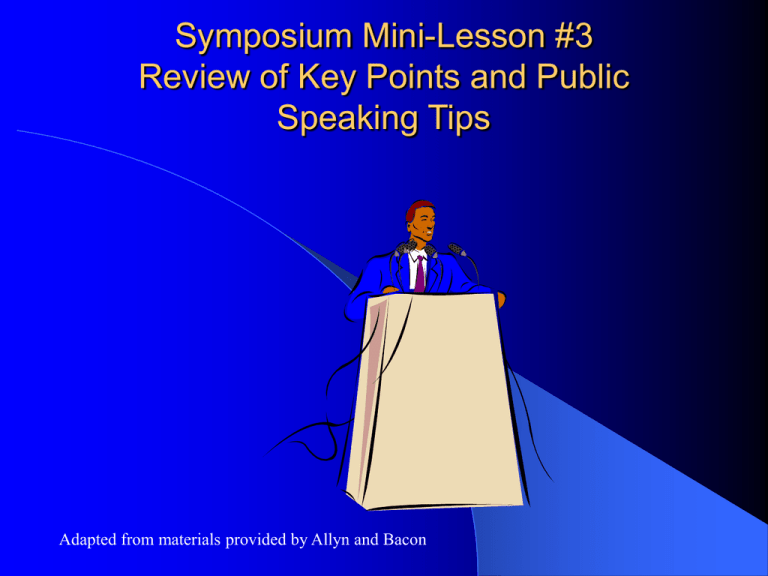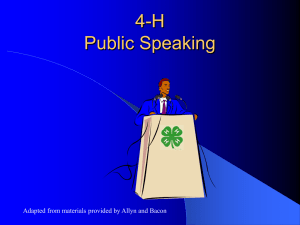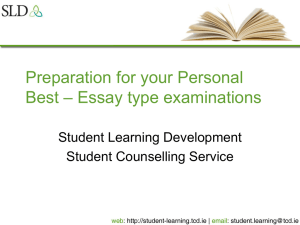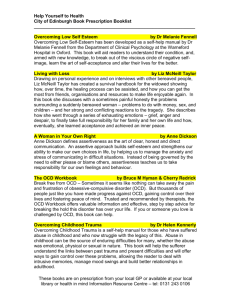File
advertisement

Symposium Mini-Lesson #3 Review of Key Points and Public Speaking Tips Adapted from materials provided by Allyn and Bacon Public Speaking Produces Anxiety in Most People People’s Biggest Fears 3. Death 2. Snakes 1. Public Speaking Overcoming Speech Anxiety Acknowledge Your Fear Act Confident Channel Nervous Energy Overcoming Speech Anxiety (con’t) Practice, Practice, Practice Simulate Setting at Home Ask Friends to Be Practice Audience Overcoming Speech Anxiety (con’t) Visualize Your Success Use Deep-breathing Techniques Focus on Message, not Fear Give Yourself a Mental Pep Talk Understand Audience and Listening People Think Faster Than They Hear People Have Short Attention Span People Jump to Conclusions People are Easily Distracted Listening Remedies Keep Speech Focused Divide Speech into Compact Segments Analyze Audience Carefully Adapt to Situation Understand The Speech Context Audience Setting The Audience Size Demographics Beliefs and Values Receptive/Antagonistic Context - The Setting Indoor/Outdoor Size and Shape of Room Arrangement of Seating Equipment Available Lighting Acoustics Understand & Define Your Purpose Inform Inspire / Persuade Entertain Introduce Accept Pay Tribute Understand the Speech Making Process Choosing/Narrowing a Topic Researching Topic Organizing Your Speech Developing an Outline Rehearsing Speech Delivering Speech Choosing an Appropriate Topic Is It Important to You? Is It Important to Your Audience? Will It Hold Audience’s Attention? Is It Manageable in the Time Available? Is It Appropriate for Oral Presentation? Is It Clear? Develop Central Idea Write a one sentence summary of speech. Sky-diving is something that everyone should try at least once in their life. Narrowing a Topic - Example Way too Broad- Protecting the Environment Better- Water Quality in My State Even Better- Well Water Problems Best! Very Specific-Utilizing Home Well Assessments to Reduce Contamination Risk Getting Topic Feedback From Members of Potential Audience From Friends From Family From Teachers Researching Topic and Finding Supporting Material Types of Supporting Material Tests of Supporting Material Types of Supporting Material Common Knowledge Direct Observation Examples & Illustrations Explanations & Descriptions Documents Tests of Supporting Material Is Information Specific? Is Source an Expert? Is Source Unbiased? Is Information Timely? Tests of Supporting Material (con’t) Is Information Relevant to Point Made? Does Information Support the Point? Is Information Timely? Ethics in Speech Preparation - Researching Take Accurate Notes When Researching Record Complete Source Citations Credit Source of Ideas When in Doubt, Cite Source Don’t Use Someone Else’s Speech! Introductions Types Functions Types of Introductions Identification with Audience Reference to Situation Statement of Purpose Statement of Importance of Topic Surprise Audience with Claim or Statistic Types of Introductions (con’t) Anecdotal Story Rhetorical Question- These only work if they’re really thought-provoking. Don’t do something like, “Have any of you ever been on a boat before, well I have.” Lame! Quotation Humor “So there I was at the summit of Mt. Killimanjaro, and I turned to the guide and said…” Functions of Introductions Get Attention Introduce Topic Provide Motivation Establish Credibility Preview Speech Conclusions Types Functions Types of Conclusions Summary Quotation Personal Reference Challenge to Audience Offer Vision of the Future Types of Conclusions Anecdotal Story Rhetorical Question Quotation Humor Remember what Dwight D. Eisenhower once said: “Things are more like they are now, than they have ever been before.” Functions of Conclusions Summarize Speech Reemphasize Main Idea Motivate Response Provide Closure Methods of Delivery Manuscript Reading- beware of getting buried in your manuscript and not making eye contact! Memorized- beware of talking too fast and sounding robotic! With Notes/ Outline- Best for most people. This can guide you through without making you bogged down. Delivering Speech Beginning Walk Calmly with Confidence to Front Establish Eye Contact Smile Naturally Deliver Introduction Delivering Speech - During Use Effective Eye Contact Use Effective Language Use Effective Gestures Be Enthusiastic Use Conversational Style Use Notes As Needed Delivering Speech - Ending “Frame” the Speech Pause before Returning to Seat – Only ask for questions if there is time. Accept Applause Graciously Elements of Vocal Delivery Speech Rate and Pauses Volume Inflection and Pitch Quality of Voice Pronunciation and Articulation Elements of Physical Delivery or Body Language Appearance Posture Facial Expression Eye Contact Movement Gestures Rehearsing Speech Recreate Setting Practice Without Memorizing Time Speech Rehearsing Speech Practice Out Loud Practice Standing Up Watch Yourself Rehearsing Speech Practice Gestures Practice Eye Contact Practice Volume Plan, Prepare, Polish, Practice, Present The better you know your material the less anxious you’ll be about presenting it. Smile and act natural. Don’t apologize for being nervous. No one will know you’re nervous unless you call attention to it. REMEMBER!!!! The best way to prepare is to start now! Don’t procrastinate and stress yourself out.










